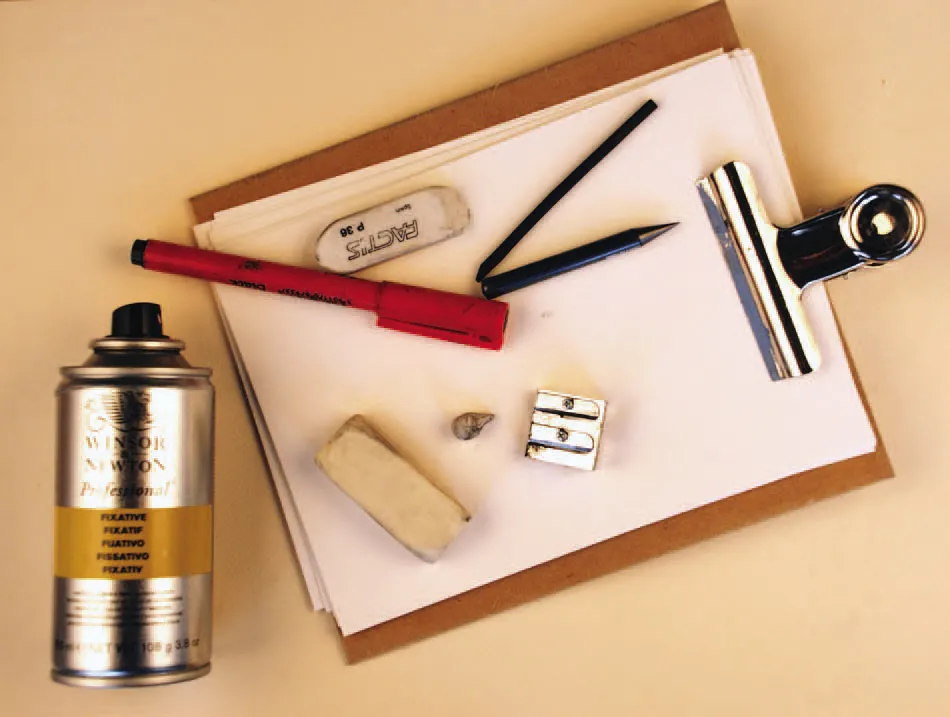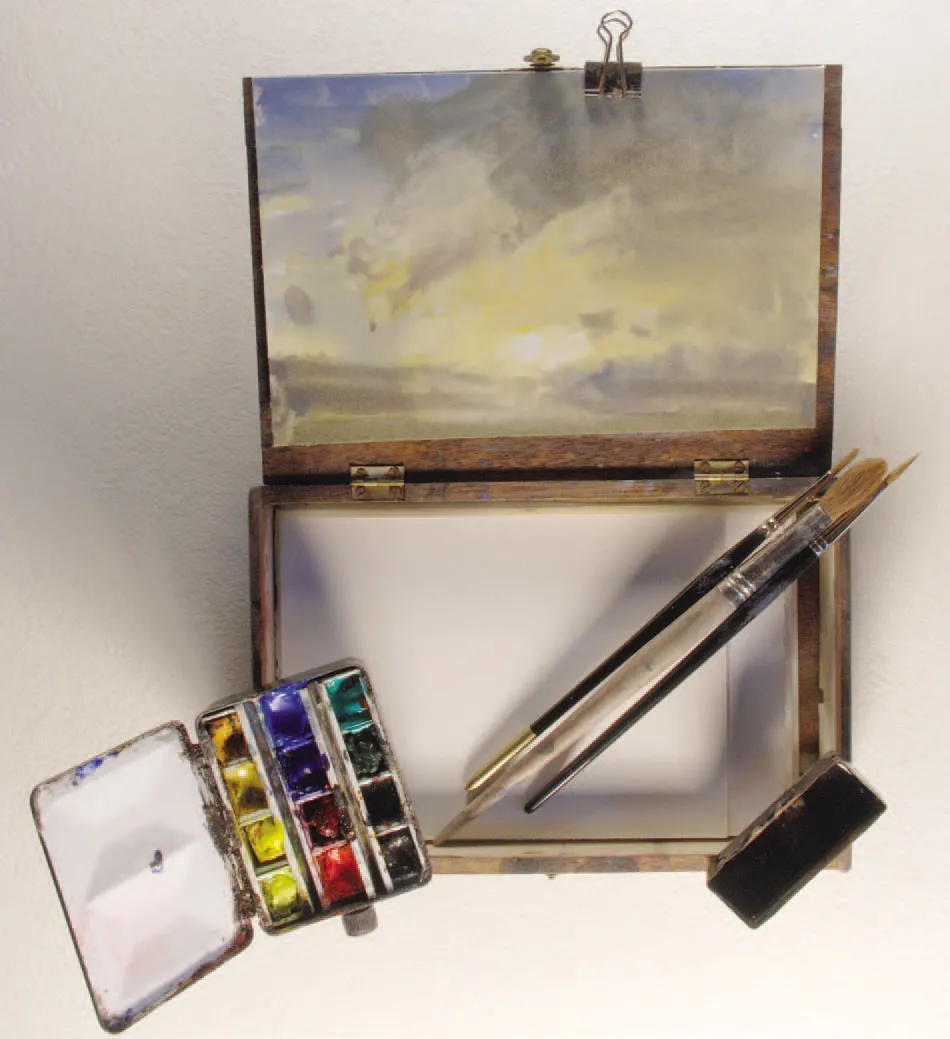![]()
CHAPTER 1
Seeing and Painting
My own experience is that it’s much easier to be aware of what I see when I’ve got a pencil or a brush in my hand. The act of making a mark closes the circuit between the world out there, my thinking eye and a developing image of what I see. It enables the question, ‘Is that what I see?’, from which the rest simply follows.
Making a drawing slows me down, makes me stand and look and, in addition to the drawing itself, gives me time to process a visual memory and experience of a place. It allows me to make the first step towards the translation from the messy and complicated three-dimensional world towards a response to the encounter on canvas or paper.
■ Western Sky, Knowle Hill and Beyond. Oil on canvas, 36 × 24 in (91 × 61 cm), Richard Pikesley.
Each medium we might use makes us look at the world in a different way. Drawn lines make us aware of the structural bones of a composition whereas loose blocks of oil paint in which edges blur and dissolve reinforces a sense of the visual world into flowing and continuous space. So, right from the beginning it’s good to work across several media, getting into the habit of using each method as a way into a different view of the landscape. Like a child growing up learning two languages, each medium is nuanced to access the visual world from a different direction.
So as we begin, let’s equip ourselves with a minimal kit with which to make these initial explorations. We’ll need something to make a drawn mark, a surface on which to work, and a source of tone to make things light or dark or somewhere in between. A few colours will complete our basic kit and leave us free to walk around in the landscape without the encumbrance of too much ‘stuff’.
What follows is probably already too long a list, so choose from it things you already have or that you can easily find. Buying a lot of equipment or materials is not necessary yet. I’m tempted to put ‘a decent pair of boots’ at the top of any list of equipment. Remember, landscape painting is essentially an outdoor pursuit, so your personal comfort and safety are essential. You won’t work effectively if you’re cold or wet through.
■ Sketchbook studies – where it all starts.
A BASIC KIT
• ‘B’ pencil and sharpener
• Pens of various sorts: dip pens, cartridge-type drawing pens, ball point, etc.
• Paper
• Paints and brushes
■ The bare necessities: a basic drawing kit.
■ Sketchbooks come in all shapes and sizes. Those with spiral bindings will lie flat but tend to self-destruct with heavy use. Buy the best paper you can find.
PAPER
Use either heavy cartridge, thick enough not to buckle when wet, or hot pressed (HP) watercolour paper with its smooth surface receptive to drawn marks. Cut the paper into working sized sheets depending on personal preference. A 30 × 22 in sheet of paper will yield four sheets of 15 × 11 in, eight sheets of 7.5 × 11 in or sixteen sheets of 7.5 × 5.5 in. I find that cut down into this smallest size, little sheets of heavy watercolour paper are a handy size for my little pocket watercolour kit and a good alternative to a small sketchbook. A lightweight drawing board just a little larger than your preferred size of paper will allow you to use bulldog clips to hold the paper firmly in place. As an alternative to individual sheets of paper by all means use a sketchbook, but choose with care. The quality of paper varies enormously, so try to find something that allows you to make drawn marks with pencil or pen and is robust enough to accept wet washes without buckling. Sketchbooks have one further disadvantage for the travelling landscape artist: as you have to turn the page to reveal a new sheet, the one you’ve been working on previously will run and blot unless left to dry fully. If I’m using a sketchbook for making watercolour notes I’ll use two, and alternate them to allow a bit of drying time.
■ Pencil and watercolour, drawn right across a double page spread. Sketchbooks are a valuable resource.
PAINTS AND BRUSHES
Watercolour, acrylics and gouache will all work well on individual sheets of paper or in sketchbooks. Each has a different quality but all have their place in gathering information. Being water-based, these media need a minimum of other materials and equipment; they dry quickly and help keep things relatively simple through the early stages of learning to paint.
■ My cigar box watercolour kit. Small enough to slip into a pocket, this little box contains everything I need to paint a small watercolour with a few sheets of heavy watercolour paper, brushes and paints. The box of paints even has a water container and water pot built into it.
Watercolour
Watercolour comes in tubes to squirt out onto a palette or in pans made workable by brushing with water. Watercolours are transparent, can be built up in layers, and combine well with pencil or pen lines, which can be seen through the washes. They can also be used as a tonal wash with just one colour over line drawing. Colour combinations in washes can be tricky initially and we’ll deal with this more fully later on.
■ Watercolours come in two types, either solid pans or liquid colour in tubes. Both are sold in various sizes.
Gouache
Gouache is sold in tubes; mix with water as with watercolour. These colours are opaque, and are a useful medium on their own and in a mixed-media approach. Originally made for designers, who needed flat colour for preparing artwork for printing, these paints also fabulous for the landscape painter as they allow you to work quickly without having to wait for overlaid washes to dry. When using these colours, try to make colour judgements wet against wet, as these paints change tone just a little as they dry, which makes ‘patching’ an area of dried colour or calibrating close tonal steps a little tricky.
Acrylics
On the face of it, acrylics have all the advantages of watercolour and gouache (and oil paint for that matter) and few disadvantages. Although I don’t often use them, as I’m a bit put off by their somewhat plastic quality, they are transparent enough in thin washes, cover well in thicker layers when mixed with a little white, and dry quickly.
Brushes for watercolour, gouache and acrylics
For now, just a few inexpensive synthetic brushes will do: a couple of pointed ones, one small and one larger, and a wash brush. In general, use the softer type for watercolour and gouache, but hog hair brushes and t...








